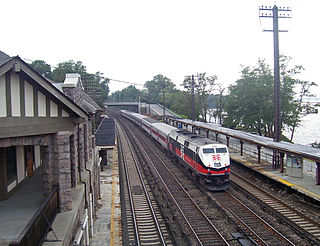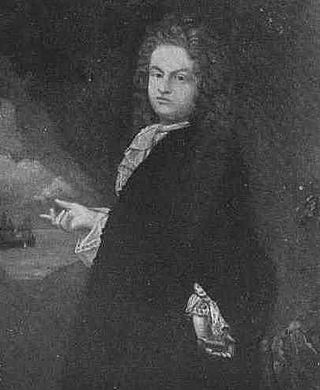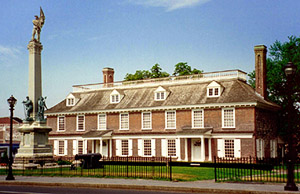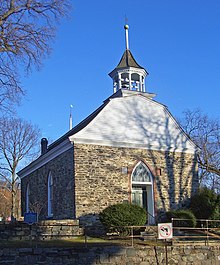
Sleepy Hollow is a village in the town of Mount Pleasant, Westchester County, New York, United States.

Sleepy Hollow Cemetery in Sleepy Hollow, New York, is the final resting place of numerous famous figures, including Washington Irving, whose 1820 short story "The Legend of Sleepy Hollow" is set in the adjacent burying ground at the Old Dutch Church of Sleepy Hollow. Incorporated in 1849 as Tarrytown Cemetery, the site posthumously honored Irving's request that it change its name to Sleepy Hollow Cemetery. It was listed on the National Register of Historic Places in 2009.

Tarrytown is a village in the town of Greenburgh in Westchester County, New York. It is located on the eastern bank of the Hudson River, approximately 25 miles (40 km) north of Midtown Manhattan in New York City, and is served by a stop on the Metro-North Hudson Line. To the north of Tarrytown is the village of Sleepy Hollow, to the south the village of Irvington and to the east unincorporated parts of Greenburgh. The Tappan Zee Bridge crosses the Hudson at Tarrytown, carrying the New York State Thruway to South Nyack, Rockland County and points in Upstate New York. The population was 11,860 at the 2020 census.

Philipse Manor station is a commuter rail stop on the Metro-North Railroad's Hudson Line, located in the Philipse Manor area of Sleepy Hollow, New York, United States.

Wolfert Acker (1667–1753) was a colonial-period American who is featured in Washington Irving's short story collection Wolfert's Roost and Miscellanies (1855). His name was recorded in all combinations of Wolfert or Wolvert as given name, and Acker, Echert, Eckar, or Ecker as surname. He was born in Flatbush, Brooklyn, New York and died at his sizable home, "Wolfert's Roost" near the site of what is now Irvington, New York in Westchester County, New York. On December 20, 1692, on land belonging to Frederick Philipse, he married Maretje Sibouts.

Sunnyside (1835) is an historic house on 10 acres along the Hudson River, in Tarrytown, New York. It was the home of the American author Washington Irving, best known for his short stories, such as "Rip Van Winkle" (1819) and "The Legend of Sleepy Hollow" (1820).

Philipsburg Manor House is a historic house in the Upper Mills section of the former sprawling Colonial-era estate known as Philipsburg Manor. Together with a water mill and trading site the house is operated as a non-profit museum by Historic Hudson Valley. It is located on US 9 in the village of Sleepy Hollow, New York.

Frederick Philipse, first Lord of the Manor of Philipseborough (Philipsburg) and patriarch of the Philipse family, was a Dutch immigrant to North America of Bohemian heritage. A merchant, he arrived in America as early as 1653. In 1662, he married Margaret Hardenbrook de Vries, a wealthy and driven widow. Together, and variously in league with slavers, pirates, and other undesirables alongside the prominent and respectable, the couple amassed a fortune.
Abraham de Revier Sr. was the first elder of the Old Dutch Church of Sleepy Hollow in Sleepy Hollow, New York when it was organized in 1697.
Dirck Gorisszen Storm was an early colonial American who recorded the first official history of the Dutch community at Sleepy Hollow. His book Het Notite Boeck der Christelyckes Kercke op de Manner of Philips Burgh is a rare document of life in colonial times. Sometimes referred to as Het Notite Boeck, the five-part book is one of the few surviving records of Dutch Colonial American village life in English-occupied New York province.
Historic Hudson Valley is a not-for-profit educational and historic preservation organization headquartered in Tarrytown, New York. The organization runs tours and events at five historic properties in Westchester County, in the lower Hudson River Valley.

Philipsburg Manor was a manor located north of New York City in Westchester County in the Province of New York. Netherlands-born Frederick Philipse I and two partners made the initial purchase of land that had been part of a Dutch patroonship owned by Adriaen van der Donck. Philipse subsequently bought his partners out and added more land before being granted a royal charter in 1693 for the 52,000 acres (21,000 ha) estate, becoming its first lord.

The Scarborough Historic District is a national historic district located in the suburban community of Scarborough-on-Hudson, in Briarcliff Manor, New York. The 376-acre (152 ha) district was added to the National Register of Historic Places in 1984, and contains seven historically and architecturally significant properties dating from the late 18th century to the early 20th century. Most of the properties are domestic, or used for education or religion. The most common architectural styles within the district are Mid-19th Century Revival and Late Victorian.

Philipse Manor Hall State Historic Site is a historic house museum located in the Getty Square neighborhood of Yonkers, New York. Originally the family seat of Philipse Manor, it is Westchester County's second oldest standing building after the Timothy Knapp House. Located near the Hudson River at Warburton Avenue and Dock Street, it is owned and operated by the New York State Office of Parks, Recreation and Historic Preservation.
Het Notite Boeck der Christelyckes kercke op de Manner of Philips Burgh is a rare surviving record book of the Old Dutch Church of Sleepy Hollow in Sleepy Hollow, New York.
Margaret Hardenbroeck de Vries Philipse was a prominent and wealthy merchant in the colonial Province of New York. She inherited great wealth from her first husband after his early death, and later married another merchant and landowner, Frederick Philipse, who became 1st Lord of Philipse Manor.

The Pocantico River is a nine-mile-long (14 km) tributary of the Hudson River in western central Westchester County, New York, United States. It rises from Echo Lake, in the town of New Castle south of the hamlet of Millwood, and flows generally southwest past Briarcliff Manor to its outlet at Sleepy Hollow. Portions of the towns of Mount Pleasant and Ossining are within its 16-square-mile (41 km2) watershed.
There are numerous nationally and locally designated historic sites and attractions in Westchester County. These include architecturally significant manors and estates, churches, cemeteries, farmhouses, African-American heritage sites, and underground railroad depots and waystations. There are sites from pre-Revolutionary and Revolutionary times, as well as battlegrounds. Westchester County also played an important role in the development of the modern suburb, and there are many associated heritage sites and museums.

Frederick Philipse II was a merchant, landowner, and politician in British America. He was the only son of Maria Sparkes, daughter of the Governor of Barbados, and Philip Philipse, eldest son of Frederick Philipse I, 1st Lord of the Philipsburg Manor. Philip predeceased his father, and family lands passed on to younger son Adolphus Philipse. Upon his uncle's death Frederick II inherited his share of Philipse lands and commercial interests, thereafter becoming the elder Philipse male and 2nd Lord of Philipsburg Manor.
Boeck is a surname. Notable people with the surname include:


















